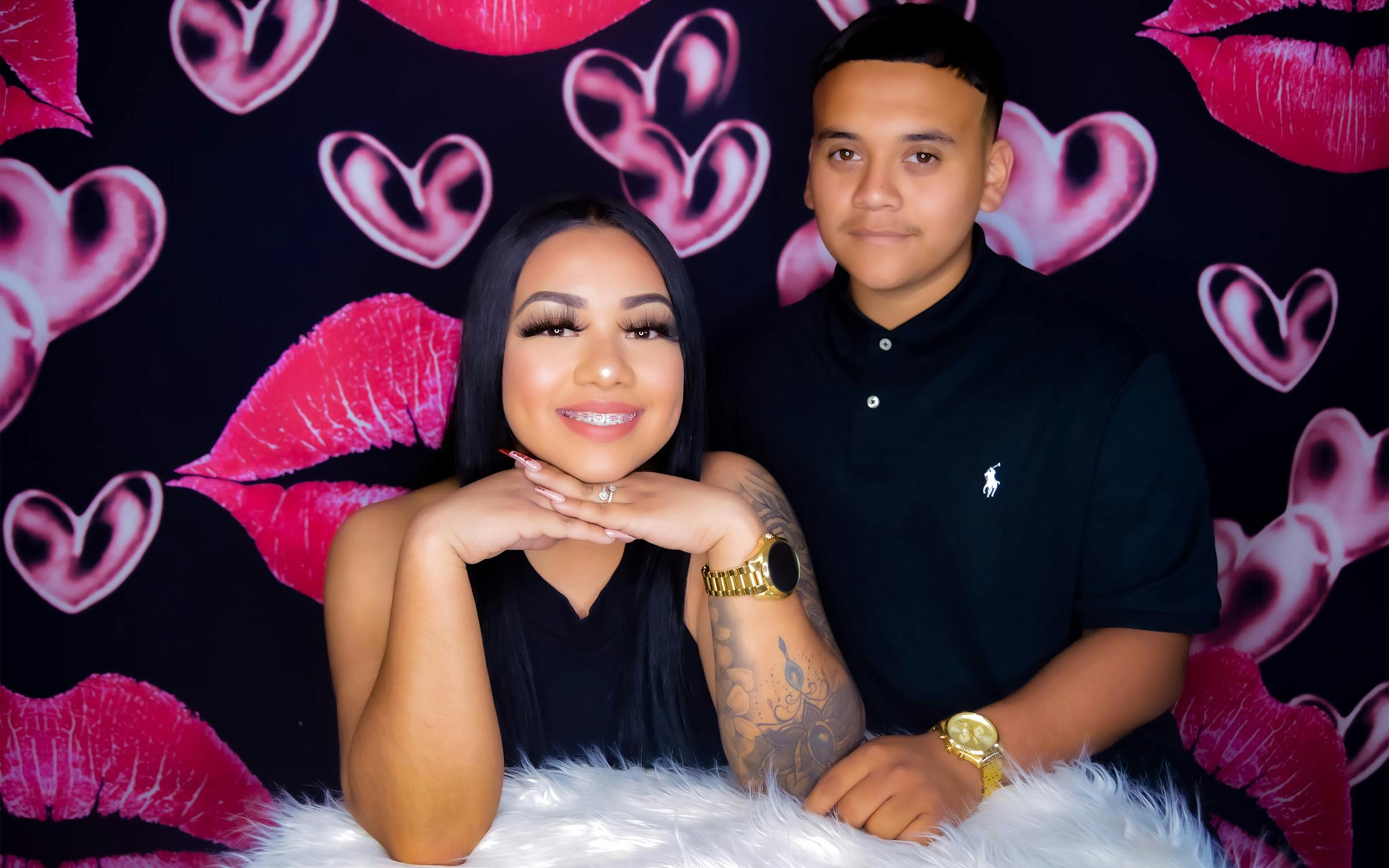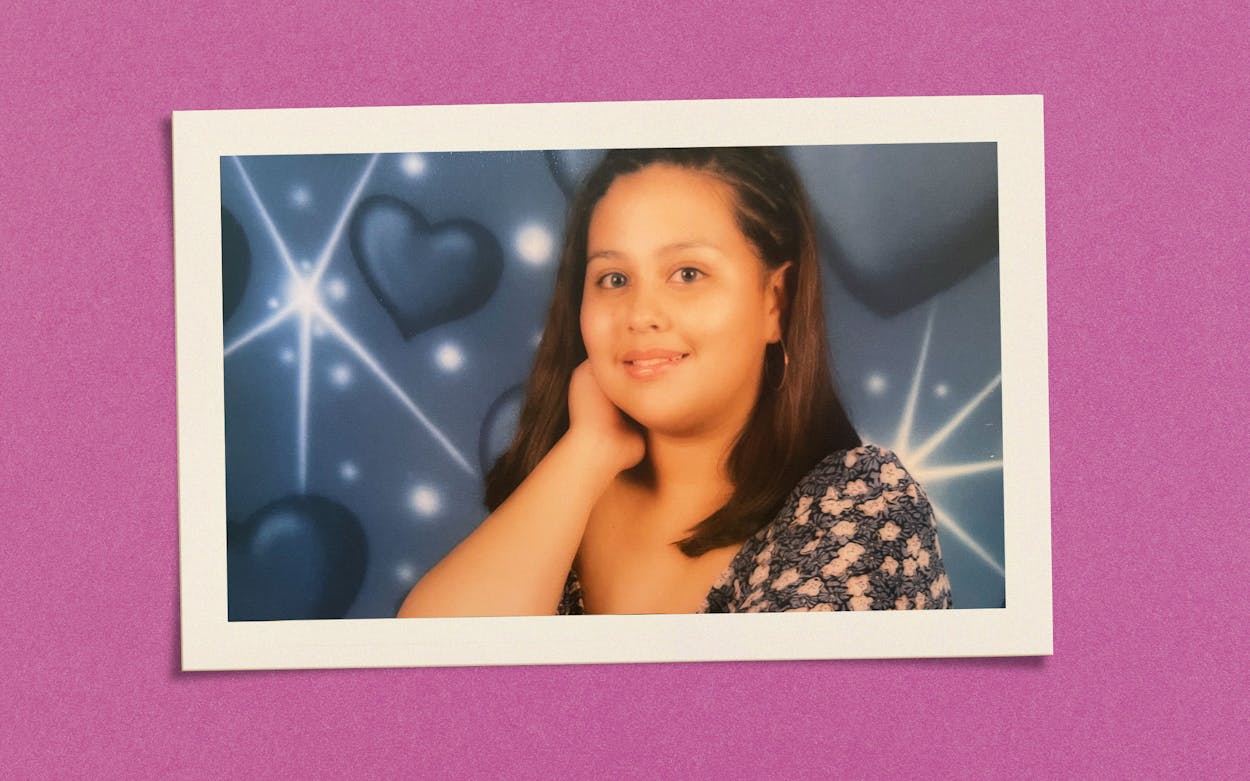In the hours before her early 2000s trips to the mall, Melody Gaitan developed a ritual. First, she’d talk with her younger sister or call her friends to coordinate their outfits. Once they’d settled on a color scheme, she’d put together her look, finishing it off by pulling her hair up into a ponytail with a matching scrunchie. She’d add on brown lip liner and a lighter lip gloss, and the final touch was her favorite accessory: a pair of gold hoops with the word “Babygirl” slashed across the middle.
With each trip to Austin’s Highland Mall, she’d plan a visit to Glamour Shots, a portrait studio franchise where customers like Gaitan and her friends could have their hair styled, their makeup done, and walk away from their photo session with a handful of wallet-size printouts. Before sending the glossy photos out to friends or crushes at school, she’d write on the back, in a 16-year-old’s lingo, “Don’t Change 4NE1.” To a teenage Gaitan, it was a message of self-love.
Now 30 years old, Gaitan has made the catchphrase the name of her business—a nineties/aughts-inspired photography studio with the airbrushed backdrops and hazy filters of her childhood. Gaitan opened Don’t Change 4NE1 in San Marcos with her brother, Alvin Gaitan Jr., in January, hoping to bring back the drama and nostalgia of glamour shot photography. “It’s so cringe to look back on some of the photos we took,” says Gaitan, laughing as she remembers some of her outfits. “But I’m glad that I have them because it was a fun way to capture the moment.”

For me, growing up in San Antonio in the 2000s, these cheesy, delightfully dramatic photos were almost inescapable. They were on full display in a gaudy gold frame in the living room, or maybe tucked away into old photo albums: glossy photos of my mom, my cousins, my tías, or even my grandma all done up with teased hair and bold eyeshadow.
A quick callout in my family group chat this week quickly resurfaced a dozen of these photos. All of them taken from the waist up, the way every Glamour Shot employee was trained. (As I learned while reporting this story, that’s because customers would cycle through different tops and accessories during a photo shoot while leaving the lower halves of their outfits unchanged.) In one portrait of my cousin Trisha, she’s resting her chin on a white satin glove, wearing a pair of diamond chandelier earrings and bright red lipstick. In another of my cousin Jessica, she’s sitting with two of her friends in front of a hazy, sepia-toned backdrop. Their hair is scrunched and curly, and they’re all sporting the skinny brows of the nineties. The photo captures the peak of 2000s Chicana style.
Not all of these photos were from Glamour Shots, which opened its first store in Dallas in 1988 and eventually peaked in 1995 with 380 locations across the world. They might have been taken at Star Shots, or Picture People, or some other photo franchise that popped up at the local mall, but they all captured the same style. It was clear that Glamour Shots was popular, but having grown up in a family dominated by women, I witnessed the unique pleasure of Latinas playing dress-up. There’s a certain level of self-confidence, a shameless inclination toward the boldest fashions and brightest colors. Like my Tía Cano would say every time we snapped a good photo of her, “the camera doesn’t lie.”
In El Paso, Leonora Campbell operates one of three remaining Glamour Shots locations in the world. She’s been in business for 30 years, carefully monitoring changes in fashion by keeping tabs on the outfits that her high school clients wear when they come to take their senior photos.
In 1991, a friend of her ex-husband introduced Campbell to Glamour Shots, showing her a booklet full of photos taken at different franchise locations. It piqued her interest, and that same year, she started training. Through Glamour Shots, she took courses in photography, learned how to pose clients, and took notes on how to frame them in the photo. Eight months later, she opened her location in the local mall. Campbell eventually outgrew the location, and set up shop at a nearby strip mall where she could accommodate larger groups.
“At the time, the glamour, the makeup, the fashion was such a huge deal,” she says. Each location had a wardrobe for clients to sift through, and in the nineties, Campbell recalls stocking the store with bustiers, sequined jackets, boas, and satin gloves. Sometimes, if a client wasn’t feeling confident enough, she’d bring out her mirror. “I would show people their features,” she said. “I’d tell people to look at their eyes, their lips, their noses. I want to show them that nobody is ugly.”
In one corner of her studio, there’s a photo of Campbell—the very first taken at her original location—where her elbow-length gold gloves are covering up her chest and she’s sporting a dramatic black and gold hat as she locks eyes with the lens. “Latinas just love to look good,” Campbell laughs. “We like looking hot and sexy—that’s the culture. We have gorgeous brown eyes, long eyelashes, and long, dark hair. It photographs very well.” Among her predominantly Hispanic clientele, she’s noticed that the photos have remained popular. Even as fashion trends came and went, she always kept her boas and satin gloves on hand for clients who wanted a throwback.
Looking back on her own Glamour Shots photos late last year, Gaitan realized that other 2000s trends, from halter tops to scrunchies and platform sneakers, were making a comeback. She scoured Etsy to see if she could find any backdrops that reminded her of her old photos, eventually landing on a few different options: a deep blue backdrop with light blue airbrushed hearts, a matching one in bright red, and a navy blue backdrop with white lipstick kisses and cursive font that reads “I love you.” When she called her brother, a photographer, to see if he’d be interested in starting up the business together, he was skeptical, but eventually agreed.
They tested the waters on social media, posting videos that received thousands of likes. Gaitan rented out a space from a friend, and by the end of the month, a steady stream of inquiries trickled in from clients looking to book a shoot. Many of them told Gaitan they were coming in because they wanted to recreate photos they’d seen of their tías or mothers.
“These photos were a really accessible way for our families to take pictures back in the day, so they have a lot of great memories attached,” says Gaitan. “Now that some of the fashion is making a comeback, it makes sense that people want to do their take on these photos.”
Gaitan Jr. is currently a part-time student at Austin Community College, while Gaitan works full time at a credit union. But on the weekends, as people file into the studio for pictures, Gaitan comes alive, queuing up a playlist she’s curated to set the mood, and working with the clients to narrow down the backdrops or props they might want. “We had a mother come in recently whose son wasn’t cooperating with the photos,” she says. “When we asked her if she wanted to take some photos by herself, her face just lit up. That’s what we want. We just want to capture that moment when someone feels good.”
- More About:
- Art
- San Marcos
- El Paso








